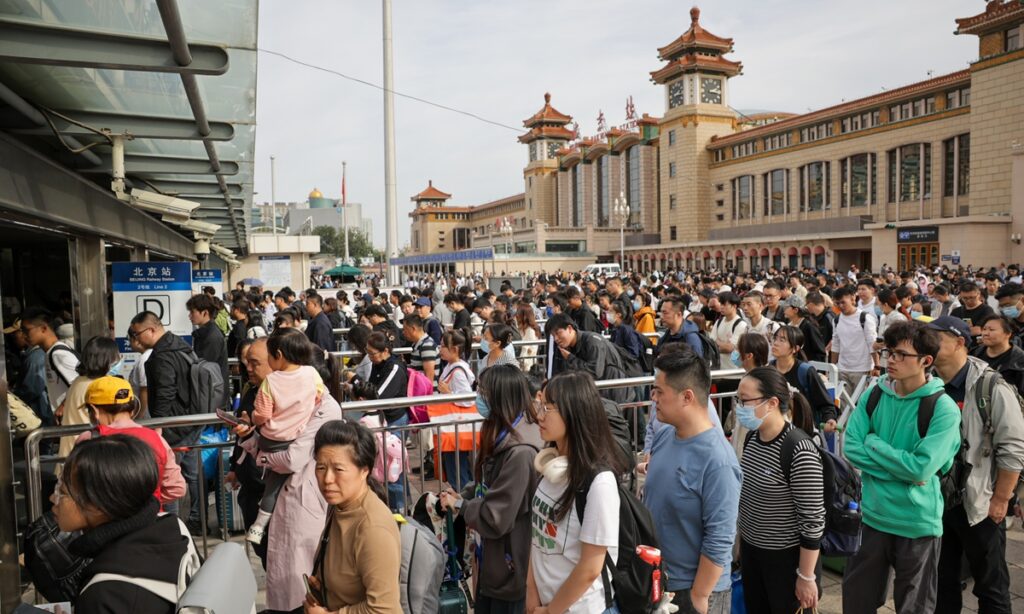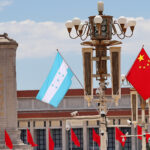As the eight-day Mid-Autumn Festival and National Day holidays wrapped up, popular tourism destinations across China on Saturday reported robust growth in both the number of trips and tourism revenue with some figures significantly surpassing the pre-pandemic levels in 2019, further cementing China’s economic recovery.
The tourism boom points to a continuous consumption recovery and endogenous growth momentum, strong evidence that defies Western doomsayers’ outlook of China’s economy. With market confidence continuously rising, GDP growth in the third quarter is expected to reach 5 percent, experts noted.
According to data released by the Beijing Municipal Bureau of Culture and Tourism on Saturday, the capital received more than 11.8 million arrivals during the Golden Week, up 48.9 percent year-on-year and 12.9 percent from 2019. Tourism revenue reached 15.57 billion yuan ($2.16 billion), up 108.2 percent on a yearly basis and up 21.9 percent compared with the 2019 level.
Shanghai, another top travel destination, saw 21.3 million trips for the holidays with transactions related to tourism up 29.7 percent year-on-year to 29.24 billion yuan, official data showed on Friday.
Meanwhile, 15.11 million trips were made in Northwest China’s Xinjiang Uygur Autonomous Region, up 9.61 percent compared with that of 2019. The region achieved tourism revenue of 20.91 billion yuan, an increase of 7.86 percent compared with the figure in 2019.
These figures show China’s ongoing tourism recovery. During the holidays, the country’s tourism economy began to enter a “new normal” driven by innovation and a new booming phase, experts noted.
“This year’s tourism spending basically exceeded the pre-epidemic level in 2019, and some scenic spots even saw a doubling or tripling of tourism figures,” Xu Xiaolei, a marketing manager at China’s CYTS Tours Holding Co, told the Global Times on Saturday.
Xu said that Chinese tourists spent the holidays in diverse and innovative ways, including enjoying time in third- and fourth-tier cities with city walks and night markets.
Nationwide, a total of 458 million passenger trips were made during the holidays, with 57.277 million passenger trips made per day on average, representing an average daily increase of 57.1 percent year-on-year, according to China’s Ministry of Transport on Saturday.
“As the gloom of the epidemic continues to evaporate and consumer confidence continues to grow, the suppressed consumption potential of the past has begun to be released, even exceeding the pre-epidemic level,” Tian Yun, a veteran economist based in Beijing, told the Global Times on Saturday.
Tian noted that domestic consumption became a new highlight of this year’s tourism sector, which also saw a boost from the 19th Asian Games in Hangzhou, East China’s Zhejiang.
Also, border authorities across China recorded a total of 11.81 million entries and exits, about 1.48 million per day on average. That was almost triple the level in 2022, and 85.1 percent of the number in the same period in 2019, according to data released by the National Immigration Administration on Saturday.
Vibrant tourism developments fully mirror China’s strong endogenous growth dynamics, and firmly rebuke foreign media’s slander against the Chinese economy, experts noted.
Xu said that from a global perspective, China’s tourism consumption market is unique because no other country has such a diverse range of tourism programs or a single market that is so bursting with creativity.
Xu expressed his confidence in the continuous tourism boom in the coming months, saying that any tourist attraction in the country can attract tourists as long as it offers higher quality and creative services.
It is very “naive” and “unprofessional” for some foreign officials and media to smear China, as they failed to notice marginal changes in economic trends, Tian said.
Tian noted that consumption must be the main engine driving economic growth in the third quarter. “If we can see a double-digit increase in retail sales in September, I think it’s possible that the GDP growth rate for the third quarter will be around 5 percent,” the expert said.
(Global Times)




